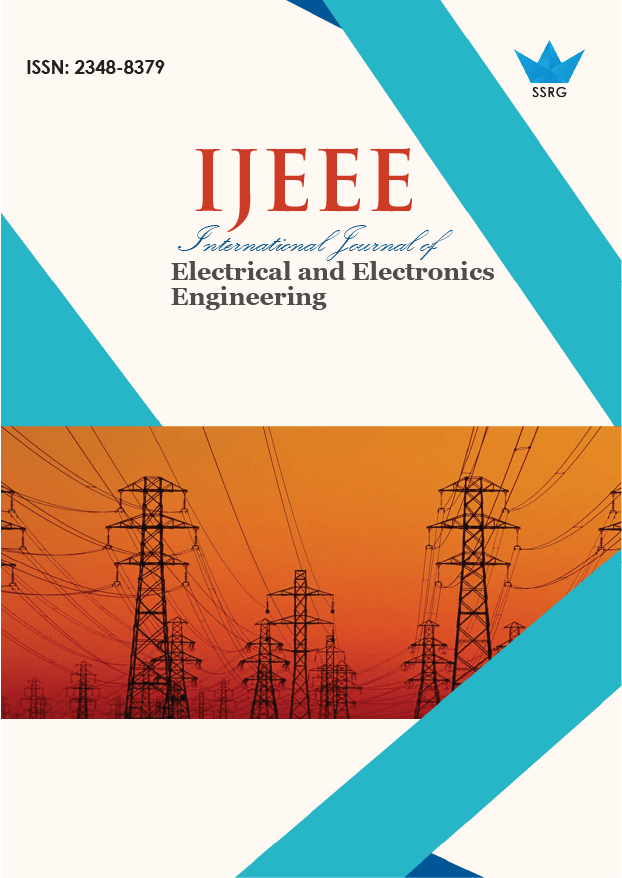Efficient Energy Management in a Hybrid Electric Vehicle Using a Double Cascade Boost Converter With ANN Optimized MPPT Technique

| International Journal of Electrical and Electronics Engineering |
| © 2025 by SSRG - IJEEE Journal |
| Volume 12 Issue 9 |
| Year of Publication : 2025 |
| Authors : Sudhakar. P, I. Kumaraswamy |
How to Cite?
Sudhakar. P, I. Kumaraswamy, "Efficient Energy Management in a Hybrid Electric Vehicle Using a Double Cascade Boost Converter With ANN Optimized MPPT Technique," SSRG International Journal of Electrical and Electronics Engineering, vol. 12, no. 9, pp. 128-138, 2025. Crossref, https://doi.org/10.14445/23488379/IJEEE-V12I9P113
Abstract:
The increasing adoption of Electric Vehicles (EVs) underscores the growing need for efficient propulsion with Energy Management Systems (EMS). An advanced EMS that integrates Photovoltaic (PV) systems with advanced converters and optimization approaches for a sustainable solution is required for energy management in EVs. Hence, this paper proposes a double cascade boost converter with an ANN-optimized MPPT technique for enhanced efficient energy management in hybrid electric vehicles. The Double Cascade Boost Converter (DCBC) is designed to enhance efficiency by reducing switching losses and providing a high voltage gain. For efficient energy extraction from the PV system under varying solar conditions, an Artificial Neural Network (ANN) optimized Secretary Bird Optimization (SBO) based Maximum Power Point Tracking (MPPT) approach is used. The motor drive uses a 3-phase Voltage Source Inverter (VSI), which converts DC into AC for driving a Brushless Direct Current (BLDC) motor, with a Recurrent Neural Network (RNN) controller employed for precise speed control of the motor. On the Energy Storage System, a Bidirectional DC-DC Converter is integrated for both supercapacitors and storage batteries, providing better predictions of State of Charge (SoC) and battery lifespan of the RNN controller. Simulation outcomes obtained from MATLAB validation illustrate that the proposed work outperforms conventional methodologies in energy conversion efficiency (98.12%) and tracking accuracy (98%).
Keywords:
Electric Vehicle, Bidirectional DC-DC Converter, Three Phase VSI, DCBC converter, and ANN Optimized SBO MPPT.
References:
[1] Liang-Rui Chen et al., “Battery Current-Sharing Power Decoupling Method for Realizing a Single-Stage Hybrid PV System,” IEEE Access, vol. 10, pp. 86864-86873, 2022.
[CrossRef] [Google Scholar] [Publisher Link]
[2] Md. Mizanur Rahman, and Yasser Abdel-Rady I. Mohamed, “Nonlinear Stability Analysis and Active Compensation of a Utility-Scale Single-Stage Grid-Connected PV System,” IEEE Access, vol. 10, pp. 133333-133347, 2022.
[CrossRef] [Google Scholar] [Publisher Link]
[3] Andrei Korneev, Yitong Niu, and Amer Ibrahim, “Electric Vehicles in the 21st Century: Historical Evolution, Environmental Impact, and Safety Challenges for Sustainable Mobility,” Khwarizmia, vol. 2024, pp. 32-38, 2024.
[CrossRef] [Google Scholar] [Publisher Link]
[4] Sairaj Arandhakar, Jayaram Nakka, and V.B. Murali Krishna, “A Comprehensive Analysis and Future Prospects on Battery Energy Storage Systems for Electric Vehicle Applications,” Energy Sources, Part A: Recovery, Utilization, and Environmental Effects, vol. 46, no. 1, pp. 13004-13031, 2024.
[CrossRef] [Google Scholar] [Publisher Link]
[5] Sahar Mohammed et al., “A Electric Vehicle Blockchain: Problems And Opportunities,” Babylonian Journal of Networking, vol. 2024, pp. 18-23, 2024.
[CrossRef] [Google Scholar] [Publisher Link]
[6] Luise Middelhauve, Cédric Terrier, and François Maréchal, “Decomposition Strategy for Districts as Renewable Energy Hubs,” IEEE Open Access Journal of Power and Energy, vol. 9, pp. 287-297, 2022.
[CrossRef] [Google Scholar] [Publisher Link]
[7] Debabrata Mazumdar et al., “GAO Optimized Sliding Mode Based Reconfigurable Step Size Pb&O MPPT Controller With Grid Integrated EV Charging Station,” IEEE Access, vol. 12, pp. 10608-10620, 2024.
[CrossRef] [Google Scholar] [Publisher Link]
[8] Radha Kushwaha, and Bhim Singh, “Bridgeless Isolated Zeta-Luo Converter-Based EV Charger With PF Preregulation,” IEEE Transactions on Industry Applications, vol. 57, no. 1, pp. 628-636, 2021.
[CrossRef] [Google Scholar] [Publisher Link]
[9] Umair Younas, Ahmet Afsin Kulaksiz, and Zunaib Ali, “Deep Learning Stack LSTM Based MPPT Control of Dual Stage 100 kWp Grid-Tied Solar PV System,” IEEE Access, vol. 12, pp. 77555-77574, 2024.
[CrossRef] [Google Scholar] [Publisher Link]
[10] Nabil A. Ahmed et al., “Soft Switching Multiphase Interleaved Boost Converter with High Voltage Gain for EV Applications,” IEEE Access, vol. 10, pp. 27698-27716, 2022.
[CrossRef] [Google Scholar] [Publisher Link]
[11] Seyed Mehdi Rakhtala Rostami, and Zeyad Al-Shibaany, “Intelligent Energy Management for Full-Active Hybrid Energy Storage Systems in Electric Vehicles Using Teaching-Learning-Based Optimization in Fuzzy Logic Algorithms,” IEEE Access, vol. 12, pp. 67665-67680, 2024.
[CrossRef] [Google Scholar] [Publisher Link]
[12] Sajib Chakraborty et al., “Scalable Modeling Approach and Robust Hardware-in-the-Loop Testing of an Optimized Interleaved Bidirectional HV DC/DC Converter for Electric Vehicle Drivetrains,” IEEE Access, vol. 8, pp. 115515-115536, 2020. [CrossRef] [Google Scholar] [Publisher Link]
[13] Erdem Gümrükcü et al., “Optimal Management for Megawatt Level Electric Vehicle Charging Stations With a Grid Interface Based on Modular Multilevel Converter,” IEEE Access, vol. 10, pp. 258-270, 2022.
[CrossRef] [Google Scholar] [Publisher Link]
[14] Sairaj Arandhakar et al., “Emerging Intelligent Bidirectional Charging Strategy Based on Recurrent Neural Network Accosting EMI and Temperature Effects for Electric Vehicle,” IEEE Access, vol. 10, pp. 121741-121761, 2022.
[CrossRef] [Google Scholar] [Publisher Link]

 10.14445/23488379/IJEEE-V12I9P113
10.14445/23488379/IJEEE-V12I9P113